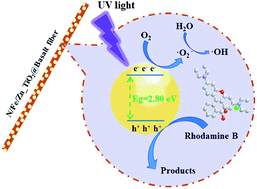N/Fe/Zn co-doped TiO2 loaded on basalt fiber with enhanced photocatalytic activity for organic pollutant degradation
Abstract
To avoid the loss of catalytic material powder, a loaded catalytic material of TiO2 with basalt fiber as the carrier (TiO2@BF) was synthesized by an improved sol–gel method. The TiO2@BF was doped with different contents of N, Fe and Zn elements and was used to degrade rhodamine B (RhB) under ultraviolet light. The physical characterization analysis indicated that the co-doping of the N, Fe and Zn elements had the effects of reducing grain size, increasing sample surface area, and narrowing the electronic band gap. The electronic band gap of nitrogen–iron–zinc co-doped TiO2@BF (N/Fe/Zn_TiO2@BF) was 2.80 eV, which was narrower than that of TiO2@BF (3.11 eV). The degradation efficiency of RhB with N/Fe/Zn_TiO2@BF as a photocatalyst was 4.3 times that of TiO2@BF and its photocatalytic reaction was a first-order kinetic reaction. Quenching experiments suggested that the reactive species mainly include photoinduced holes (h+), superoxide radicals (˙O2−) and hydroxyl radicals (˙OH). In brief, this study provides a prospective loaded catalytic material and routine for the degradation of organic contaminants in water by a photocatalytic process.



 Please wait while we load your content...
Please wait while we load your content...